The Properties of Lightweight Aggregates Pre-Coated with Cement Pastes and Their Suitability for Concrete
Abstract
:1. Introduction
2. Materials and Methods
2.1. Pre-Coating of Lightweight Aggregates with Cement Paste and Their Tests
2.2. Preparation of Concretes with Impregnated LWAs and Their Tests
3. Results
3.1. Results of Plain and Pre-Coated Aggregates Tests
3.1.1. Assessment of Covering LWA with Cement Paste
3.1.2. Particle Density of Plain and Pre-Coated Aggregates
3.1.3. Crashing Strength for Plain and Pre-Coated Aggregates
3.1.4. Water Absorption and Its Development in Time for Plain and Pre-Coated Aggregates
3.2. Results of Hardened Concrete Tests
3.2.1. Density of Concretes with Plain and Pre-Coated Aggregates
3.2.2. Compressive Strength of Concretes with Plain and Pre-Coated Aggregates
3.2.3. Water Absorption of Concretes with Plain and Pre-Coated Aggregates
4. Discussion
4.1. The Influence of Aggregates Pre-Coating on Their Properties
4.1.1. Covering LWA with Cement Paste
4.1.2. Particle Density of Plain and Pre-Coated Aggregates
4.1.3. Crashing Strength for Plain and Pre-Coated Aggregates
4.1.4. Water Absorption and Its Development in Time for Plain and Pre-Coated Aggregates
4.2. The Influence of Aggregates Pre-Coating on Concrete Properties
4.2.1. Density of Concretes with Plain and Pre-Coated Aggregates
4.2.2. Compressive Strength of Concretes with Plain and Pre-Coated Aggregates
4.2.3. Water Absorption of Concretes with Plain and Pre-Coated Aggregates
5. Conclusions
- The effectiveness of strengthening and tightening of lightweight aggregate by its impregnation with cement paste is mainly dependent on the aggregate type, especially on its porosity and pore structure. The other parameters analyzed in this research, i.e., aggregate size, strength and rheology of cement paste, initial LWA moisture content, were of less importance.
- The most pronounced influence of LWA impregnation with cement paste was observed for water absorption. The surface tightening effect resulted in a significant reduction in water absorption of all five tested aggregates. The aggregates coated with cement paste revealed water absorption 1.8–3.7 times lower than for plain LWAs.
- Verification of the influence of pre-coating of selected LWAs with cement pastes on the concrete properties proved that the aggregate impregnation is a very effective method to enhance concrete properties. Although the application of pre-coated aggregates resulted in a higher concrete density (by up to 19%), the strength increase (by up to 107%) and the water absorption reduction (by up to 52%) were much more pronounced.
Author Contributions
Funding
Informed Consent Statement
Data Availability Statement
Acknowledgments
Conflicts of Interest
References
- Chandra, S.; Berntsson, L. Lightweight Aggregate Concrete: Science, Technology and Applications, 1st ed.; William Andrew: Norwich, NY, USA, 2002. [Google Scholar]
- Clarke, J. Structural Lightweight Aggregate Concrete; Chapman &Hall: Glasgow, Scotland, 1993. [Google Scholar]
- Neville, A.M. Properties of Concrete, 5th ed.; Pearson Education Limited: London, UK, 2012. [Google Scholar]
- Domagała, L. Structural Lightweight Aggregate Concrete /Konstrukcyjne Lekkie Betony Kruszywowe; CUT Publishing House: Cracow, Poland, 2014. (In Polish) [Google Scholar]
- Tang, P.; Brouwers, H.J.H. The Durability and Environmental Properties of Self-Compacting Concrete Incorporating Cold Bonded Lightweight Aggregates Produced from Combined Industrial Solid Wastes. Constr. Build. Mater. 2018, 167, 271–285. [Google Scholar] [CrossRef]
- Fujiki, E.; Kokubu, K.; Hosaka, T. Freezing and Thawing Resistance of Lightweight Aggregate Concrete. In Proceedings of the IV CANMET/ACI/JCI International Conference, Tokushima, Japan, 1 January 1998; pp. 791–814. [Google Scholar]
- Lotfy, A.; Hossain, K.M.A.; Lachemi, M. Durability Properties of Lightweight Self-Consolidating Concrete Developed with Three Types of Aggregates. Constr. Build. Mater. 2016, 106, 43–54. [Google Scholar] [CrossRef]
- Bogas, J.A.; Real, S. A Review on the Carbonation and Chloride Penetration Resistance of Structural Lightweight Aggregate Concrete. Materials 2019, 12, 3456. [Google Scholar] [CrossRef] [Green Version]
- Domagała, L. Durability of Structural Lightweight Concrete with Sintered Fly Ash Aggregate. Materials 2020, 13, 4565. [Google Scholar] [CrossRef]
- Smeplass, S.; Hammer, T.; Sandvik, M. Production of Structural High Strength LWAC with Initially Dry Aggregates. In Proceedings of the Congress on Structural Lightweight Aggregate Concrete, Sandefjord, Norway, 20–24 June 1995; pp. 390–396. [Google Scholar]
- Sandvik, M.; Hammer, T. The Development and Use of High Performance Lightweight Aggregate Concrete. In Proceedings of the Congress on Structural Lightweight Aggregate Concrete, Sandefjord, Norway, 20–24 June 1995; pp. 617–627. [Google Scholar]
- Bogas, J.A.; Gomes, A.; Gomes, M.G. Estimation of Water Absorbed by Expanding Clay Aggregates during Structural Lightweight Concrete Production. Mater. Struct. /Mater. Et Constr. 2012, 45, 1565–1576. [Google Scholar] [CrossRef]
- Domagała, L. The Effect of Lightweight Aggregate Water Absorption on the Reduction of Water-Cement Ratio in Fresh Concrete. In Procedia Engineering; Elsevier Ltd.: Amsterdam, The Netherlands, 2015; pp. 206–213. [Google Scholar] [CrossRef] [Green Version]
- Hammer, T.; Smeplass, S. The Influence of Lightweight Aggregate Properties on Material Properties of the Concrete. In Proceedings of the Congress on Structural Lightweight Aggregate Concrete, Sandefjord, Norway, 20–24 June 1995; pp. 517–532. [Google Scholar]
- Domagala, L. Size Effect in Compressive Strength Tests of Cored Specimens of Lightweight Aggregate Concrete. Materials 2020, 13, 1187. [Google Scholar] [CrossRef] [Green Version]
- Haque, M.N.; Al-Khaiat, H.; Kayali, O. Strength and Durability of Lightweight Concrete. Cem. Concr. Compos. 2004, 26, 307–314. [Google Scholar] [CrossRef]
- Bogas, J.A.; Gomes, G.; Real, S. Capillary Absorption of Structural Lightweight Aggregate Concrete. Mater. Struct. 2015, 48, 2869–2883. [Google Scholar] [CrossRef]
- Nozahic, V.; Amziane, S. Influence of Sunflower Aggregates Surface Treatments on Physical Properties and Adhesion with a Mineral Binder. Compos. Part. A: Appl. Sci. Manuf. 2012, 43, 1837–1849. [Google Scholar] [CrossRef]
- Domagała, L. The Influence of Porous Aggregate on Microstructure of the Interfacial Transition Zone in Lightweight Concrete. Cem. Wapno Beton 2011, 2, 111–114. [Google Scholar]
- Wasserman, R.; Bentur, A. Interfacial Interactions in Lightweight Aggregate Concretes and Their Influence on the Concrete Strength. Cem. Concr. Compos. 1996, 18, 67–76. [Google Scholar] [CrossRef]
- Kareem, A.I.; Nikraz, H.; Asadi, H. Performance of Hot-Mix Asphalt Produced with Double Coated Recycled Concrete Aggregates. Constr. Build. Mater. 2019, 205, 425–433. [Google Scholar] [CrossRef]
- Zhao, Z.; Wang, S.; Lu, L.; Gong, C. Evaluation of Pre-Coated Recycled Aggregate for Concrete and Mortar. Constr. Build. Mater. 2013, 43, 191–196. [Google Scholar] [CrossRef]
- Mistri, A.; Dhami, N.; Bhattacharyya, S.K.; Barai, S.V.; Mukherjee, A.; Biswas, W.K. Environmental Implications of the Use of Bio-Cement Treated Recycled Aggregate in Concrete. Resour. Conserv. Recycl. 2021, 167, 105436. [Google Scholar] [CrossRef]
- Wu, F.; Yu, Q.; Liu, C.; Brouwers, H.J.H.; Wang, L. Effect of Surface Treatment of Apricot Shell on the Performance of Lightweight Bio-Concrete. Constr. Build. Mater. 2019, 229, 116859. [Google Scholar] [CrossRef]
- SallI Bideci, Ö. The Effect of High Temperature on Lightweight Concretes Produced with Colemanite Coated Pumice Aggregates. Constr. Build. Mater. 2016, 113, 631–640. [Google Scholar] [CrossRef]
- Yang, L.; Kou, S.; Song, X.; Lu, M.; Wang, Q. Analysis of Properties of Pervious Concrete Prepared with Difference Paste-Coated Recycled Aggregate. Constr. Build. Mater. 2021, 269, 121244. [Google Scholar] [CrossRef]
- Bideci, S.Ö.; Bideci, A.; Gültekin, A.H.; Oymael, S.; Yildirim, H. Polymer Coated Pumice Aggregates and Their Properties. Compos. Part. B Eng. 2014, 67, 239–243. [Google Scholar] [CrossRef]
- Akyuncu, V.; Sanliturk, F. Investigation of Physical and Mechanical Properties of Mortars Produced by Polymer Coated Perlite Aggregate. J. Build. Eng. 2021, 38, 102182. [Google Scholar] [CrossRef]
- Bideci, A.; Gültekin, A.H.; Yildirim, H.; Oymael, S.; Bideci, Ö.S. Internal Structure Examination of Lightweight Concrete Produced with Polymer-Coated Pumice Aggregate. Compos. Part. B Eng. 2013, 54, 439–447. [Google Scholar] [CrossRef]
- Alghamri, R.; Kanellopoulos, A.; Al-Tabbaa, A. Impregnation and Encapsulation of Lightweight Aggregates for Self-Healing Concrete. Constr. Build. Mater. 2016, 124, 910–921. [Google Scholar] [CrossRef]
- Sukontasukkul, P.; Sangpet, T.; Newlands, M.; Yoo, D.Y.; Tangchirapat, W.; Limkatanyu, S.; Chindaprasirt, P. Thermal Storage Properties of Lightweight Concrete Incorporating Phase Change Materials with Different Fusion Points in Hybrid Form for High Temperature Applications. Heliyon 2020, 6, e04863. [Google Scholar] [CrossRef]
- Felekolu, B. A Method for Improving the Early Strength of Pumice Concrete Blocks by Using Alkyl Alkoxy Silane (AAS). Constr. Build. Mater. 2012, 28, 305–310. [Google Scholar] [CrossRef]
- Ismail, S.; Ramli, M. Mechanical Strength and Drying Shrinkage Properties of Concrete Containing Treated Coarse Recycled Concrete Aggregates. Constr. Build. Mater. 2014, 68, 726–739. [Google Scholar] [CrossRef]
- Wang, X.F.; Yang, Z.H.; Fang, C.; Wang, W.; Liu, J.; Xing, F. Effect of Carbonate-Containing Self-Healing System on Properties of a Cementitious Composite: Fresh, Mechanical, and Durability Properties. Constr. Build. Mater. 2020, 235, 117442. [Google Scholar] [CrossRef]
- Alazhari, M.; Sharma, T.; Heath, A.; Cooper, R.; Paine, K. Application of Expanded Perlite Encapsulated Bacteria and Growth Media for Self-Healing Concrete. Constr. Build. Mater. 2018, 160, 610–619. [Google Scholar] [CrossRef]
- Uthaichotirat, P.; Sukontasukkul, P.; Jitsangiam, P.; Suksiripattanapong, C.; Sata, V.; Chindaprasirt, P. Thermal and Sound Properties of Concrete Mixed with High Porous Aggregates from Manufacturing Waste Impregnated with Phase Change Material. J. Build. Eng. 2020, 29, 101111. [Google Scholar] [CrossRef]
- Kulkarni, P.; Muthadhi, A. Improving Thermal and Mechanical Property of Lightweight Concrete Using N-Butyl Stearate/Expanded Clay Aggregate with Alccofine1203. Int. J. Eng. Trans. A Basics 2020, 33, 1842–1851. [Google Scholar] [CrossRef]
- Al-Mohamadawi, A.; Benhabib, K.; Dheilly, R.M.; Goullieux, A. Influence of Lignocellulosic Aggregate Coating with Paraffin Wax on Flax Shive and Cement-Shive Composite Properties. Constr. Build. Mater. 2016, 102, 94–104. [Google Scholar] [CrossRef]
- Li, W.; Ling, C.; Jiang, Z.; Yu, Q.Q. Evaluation of the Potential Use of Form-Stable Phase Change Materials to Improve the Freeze-Thaw Resistance of Concrete. Constr. Build. Mater. 2019, 203, 621–632. [Google Scholar] [CrossRef]
- Sasanipour, H.; Aslani, F. Durability Assessment of Concrete Containing Surface Pretreated Coarse Recycled Concrete Aggregates. Constr. Build. Mater. 2020, 264, 120203. [Google Scholar] [CrossRef]
- Zhang, M.H.; Gjørv, O.E. Penetration of Cement Paste into Lightweight Aggregate. Cem. Concr. Res. 1992, 22, 47–55. [Google Scholar] [CrossRef]
- Zhang, M.H.; Gjørv, O.E. Microstructure of the Interfacial Zone between Lightweight Aggregate and Cement Paste. Cem. Concr. Res. 1990, 20, 610–618. [Google Scholar] [CrossRef]
- Punkki, J.; Giørv, O. Water Absorption by High-Strength Lightweight Aggregate. In Proceedings of the Congress on High Strength Concrete, Lillehammer, Norway, 20–23 June 1993; pp. 713–721. [Google Scholar]
- EN 1097–3:1998. Tests for Mechanical and Physical Properties of Aggregates-Part. 3: Determination of Loose Bulk Density and Voids; European Committee for Standardization: Brussels, Belgium, 1998. [Google Scholar]
- EN 1097–6:2013. Tests for Mechanical and Physical Properties of Aggregates-Part. 6: Determination of Particle Density and Water Absorption; European Committee for Standardization: Brussels, Belgium, 2013. [Google Scholar]
- EN 13055:2016. Lightweight Aggregates; European Committee for Standardization: Brussels, Belgium, 2016. [Google Scholar]
- EN 12350–5:2019. Testing Fresh Concrete-Part. 5: Flow Table Test; European Committee for Standardization: Brussels, Belgium, 2019. [Google Scholar]
- EN 206:2013+A1:2016/FprA2. Concrete—Specification, Performance, Production and Conformity; European Committee for Standardization: Brussels, Belgium, 2020. [Google Scholar]
- EN 12390–2:2019. Testing Hardened Concrete-Part. 2: Making and Curing Specimens for Strength Tests; European Committee for Standardization: Brussels, Belgium, 2019. [Google Scholar]
- EN 12390–7:2009. Testing Hardened Concrete-Part. 7: Density of Hardened Concrete; European Committee for Standardization: Brussels, Belgium, 2009. [Google Scholar]
- EN 12390–3:2019. Testing Hardened Concrete-Part. 3: Compressive Strength of Test. Specimens; European Committee for Standardization: Brussels, Belgium, 2009. [Google Scholar]
- PN-88/B-06250. Beton Zwykły; Polski Komitet Normalizacyjny: Warsaw, Poland, 1988. [Google Scholar]

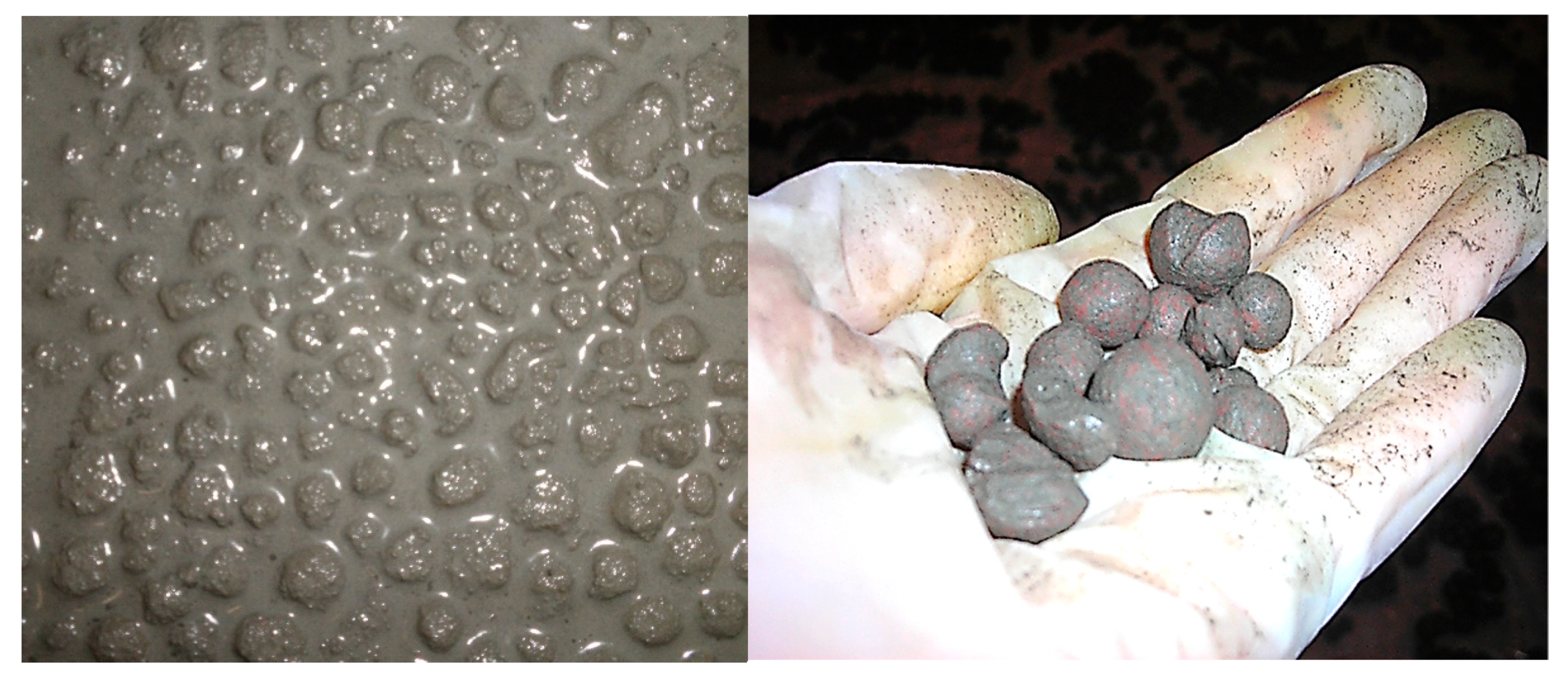
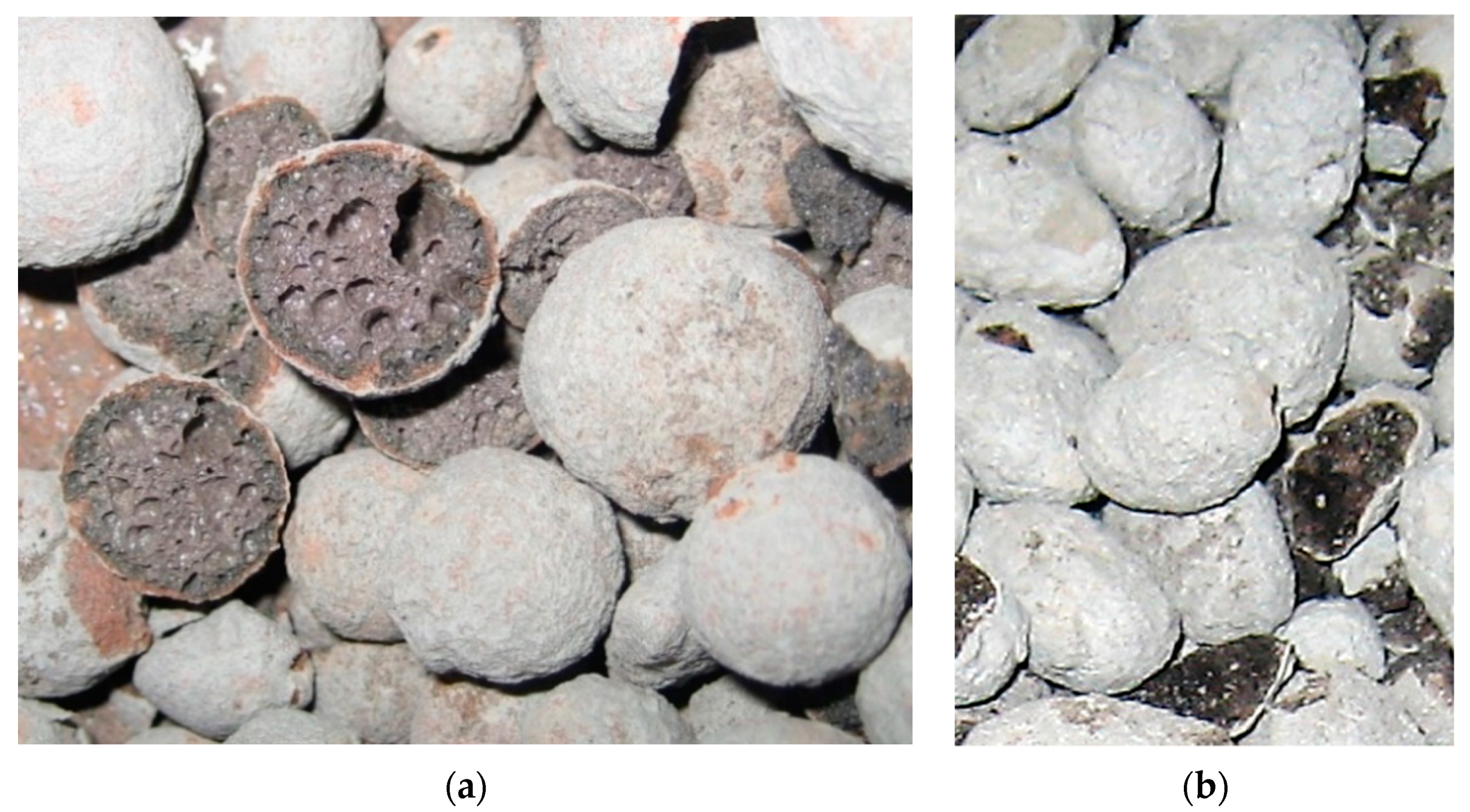



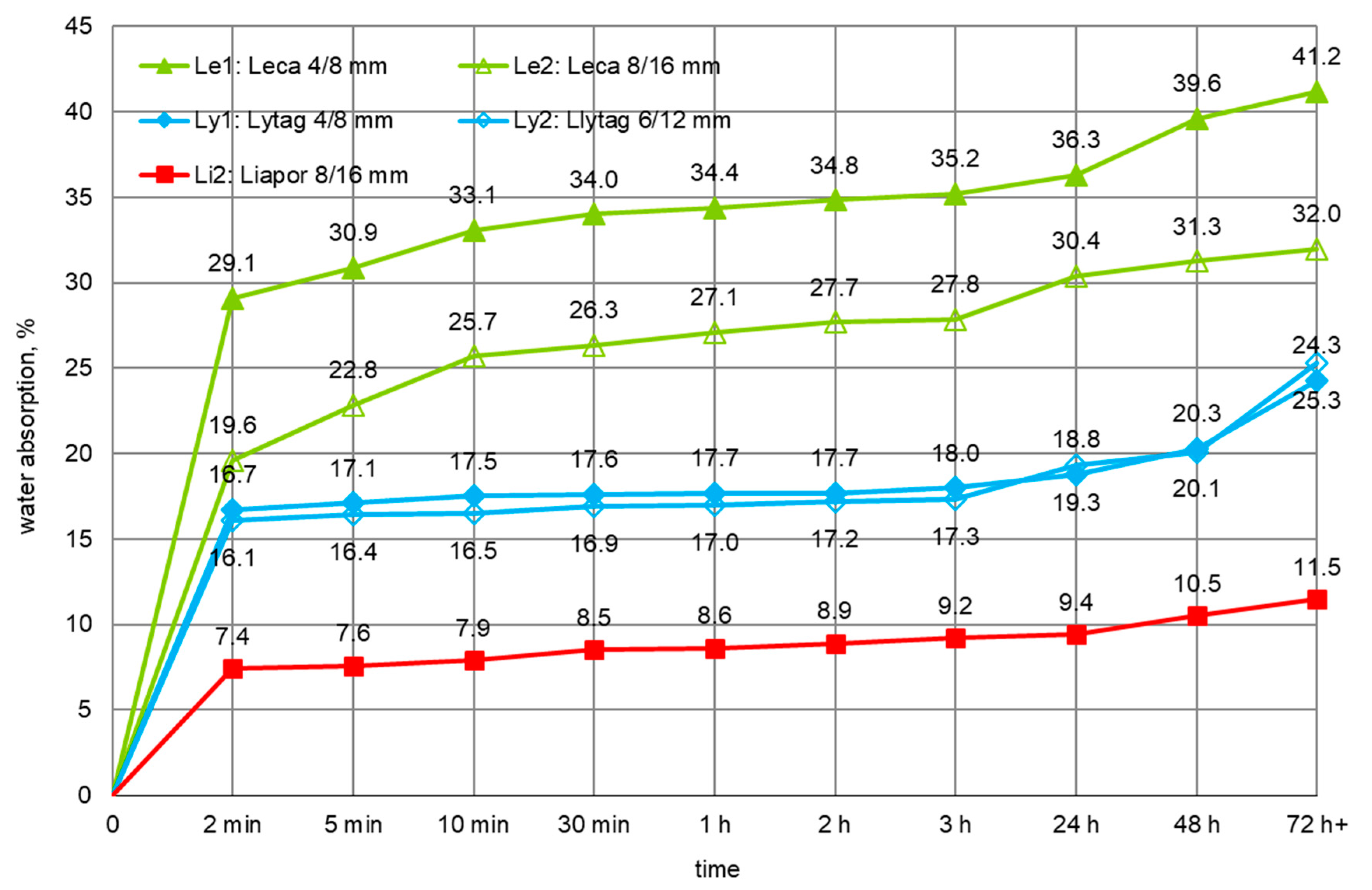
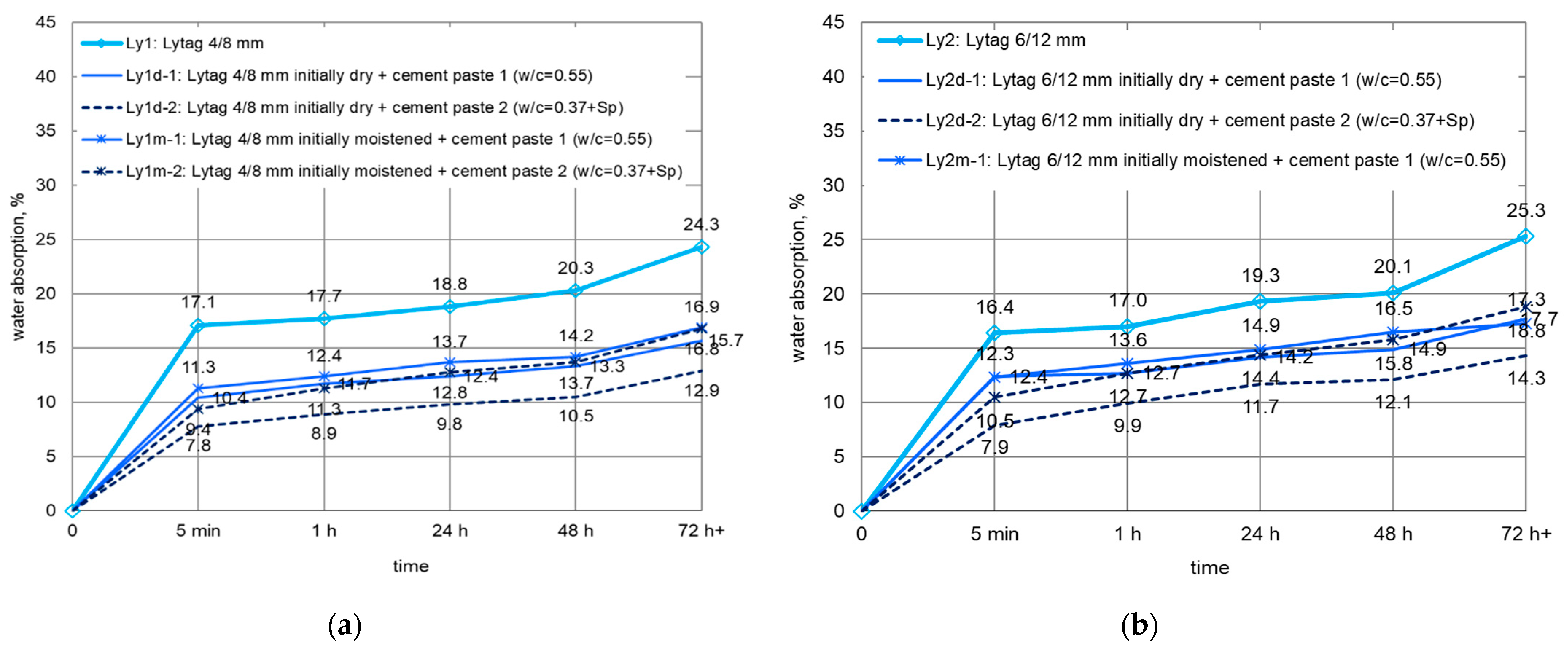
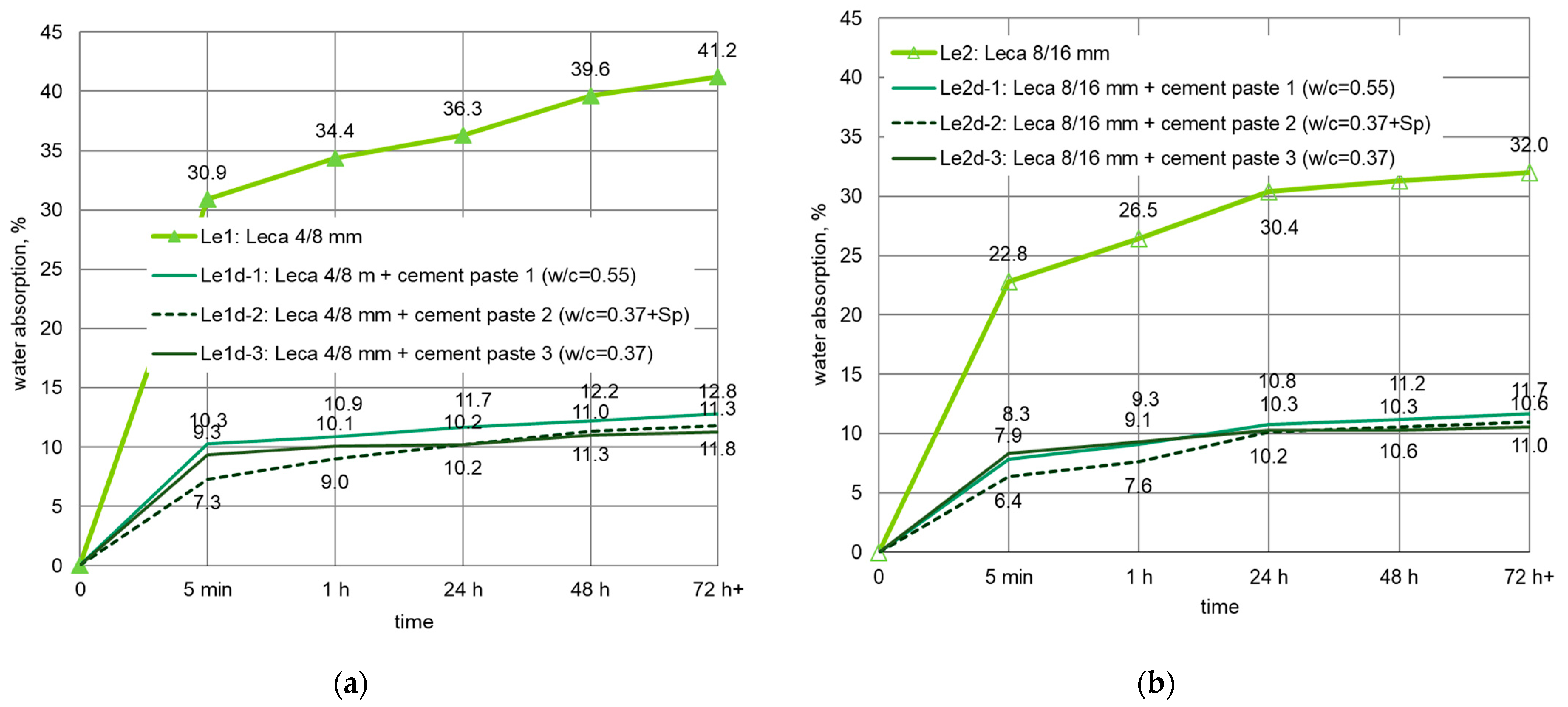
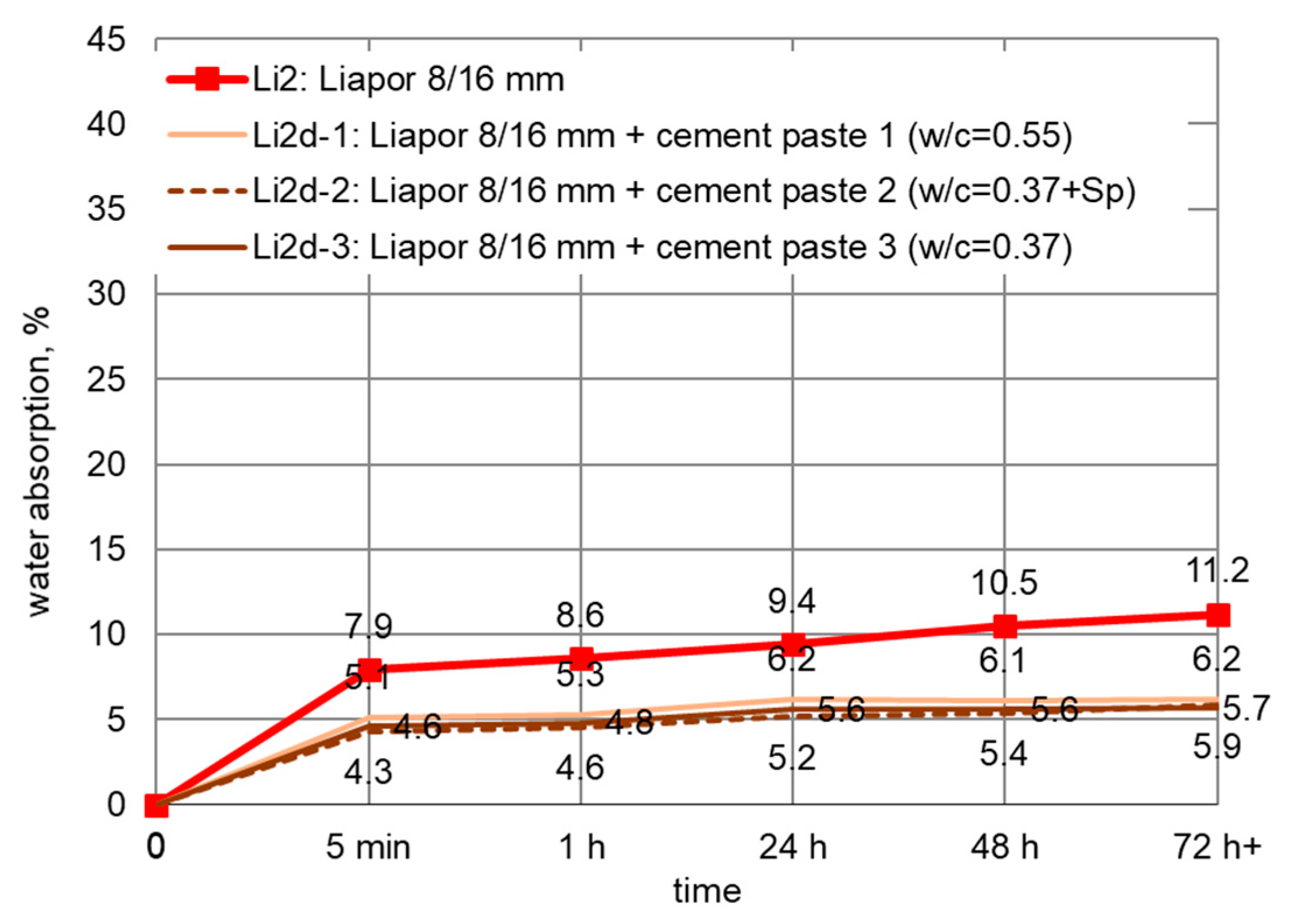


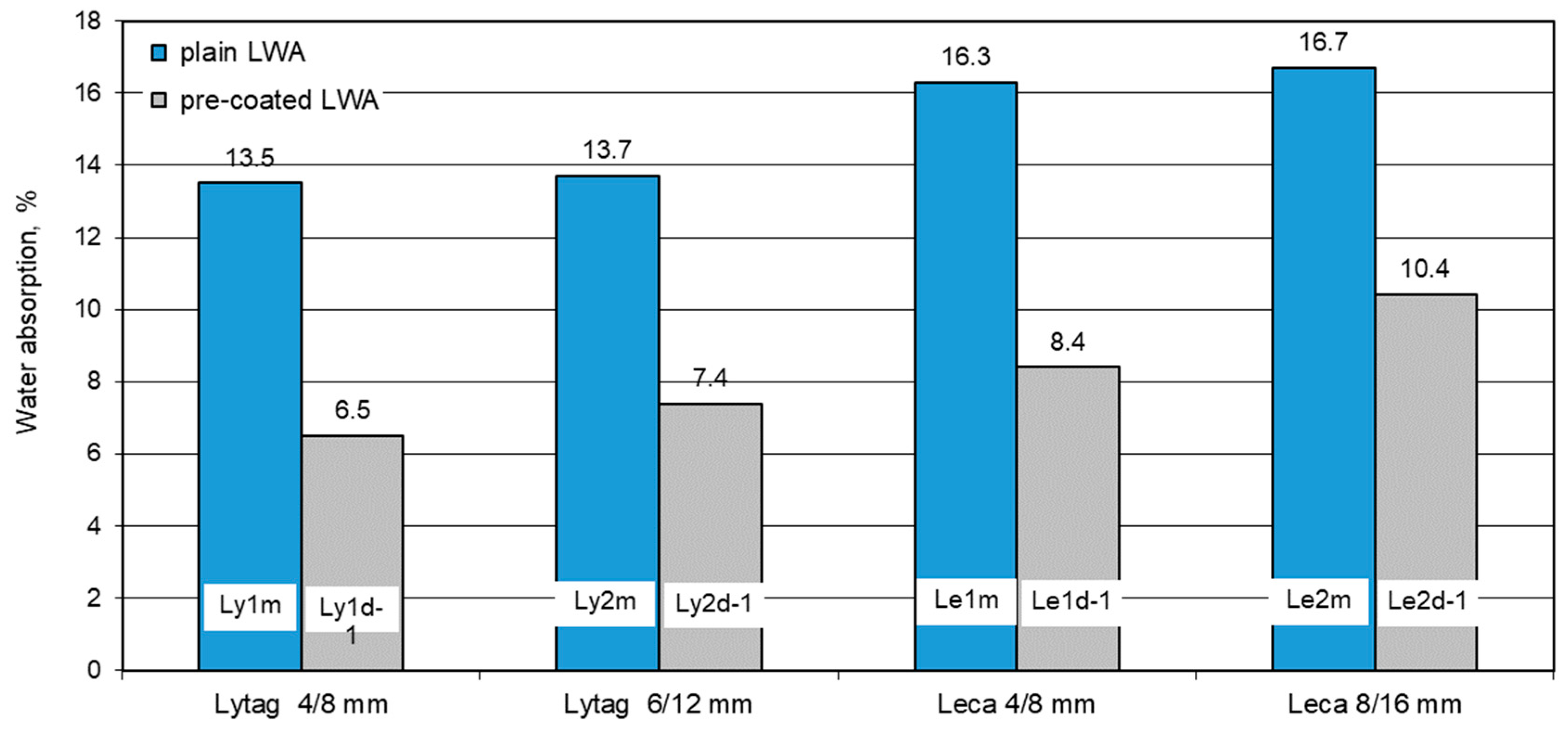

| LWA Type | Fraction | LWA Designation | Particle Density, kg/m3 | Bulk Density, kg/m3 | Porosity, % | Water Absorption after 24 h, % | Max. Water Absorption, % | Crushing Resistance, MPa |
|---|---|---|---|---|---|---|---|---|
| Lytag | 4/8 mm | Ly1 | 1320 | 730 | 47 | 18.8 | 24.3 | 8.0 |
| Lytag | 6/12 mm | Ly2 | 1340 | 720 | 46 | 19.3 | 25.3 | 7.2 |
| Leca | 4/8 mm | Le1 | 550 | 330 | 80 | 36.4 | 41.2 | 1.4 |
| Leca | 8/16 mm | Le2 | 560 | 310 | 80 | 30.7 | 32.0 | 1.2 |
| Liapor | 8/16 mm | Li2 | 780 | 460 | 71 | 9.4 | 11.5 | 1.9 |
| Cement Paste Designation | Water-Cement Ratio (w/c) | Superplasticizer, in% of Cement Mass |
|---|---|---|
| 1 | 0.55 | 0 |
| 2 | 0.37 | 1.0 |
| 3 | 0.37 | 0 |
| Component | CaO, % | SiO2, % | Al2O3, % | Fe2O3, % | SO3, % | MgO, % | Na2Oeqv., % | Loss of Ignition, % |
|---|---|---|---|---|---|---|---|---|
| CEM I 42,5R | 63.6 | 22.1 | 5.6 | 3.1 | 2.6 | 1.2 | 0.8 | 0.9 |
| Lytag | 2.2 | 58.0 | 22.0 | 3.1 | 0.3 | 1.4 | 0.9 | <4 |
| No | LWA Designation | LWA Type | LWA Fraction | LWA Moisture Content, % | Cement Paste Type |
|---|---|---|---|---|---|
| 1 | Ly1d | Lytag | 4/8 mm | 0 | - |
| 2 | Ly1d-1 | Lytag | 4/8 mm | 0 | 1 |
| 3 | Ly1d-2 | Lytag | 4/8 mm | 0 | 2 |
| 4 | Ly1m-1 | Lytag | 4/8 mm | 17 | 1 |
| 5 | Ly1m-2 | Lytag | 4/8 mm | 17 | 2 |
| 6 | Ly2d | Lytag | 6/12 mm | 0 | - |
| 7 | Ly2d-1 | Lytag | 6/12 mm | 0 | 1 |
| 8 | Ly2d-2 | Lytag | 6/12 mm | 0 | 2 |
| 9 | Ly2m-1 | Lytag | 6/12 mm | 18 | 1 |
| 10 | Ly2m-2 | Lytag | 6/12 mm | 18 | 2 |
| 11 | Le1d | Leca | 4/8 mm | 0 | - |
| 12 | Le1d-1 | Leca | 4/8 mm | 0 | 1 |
| 13 | Le1d-2 | Leca | 4/8 mm | 0 | 2 |
| 14 | Le1d-3 | Leca | 4/8 mm | 0 | 3 |
| 15 | Le2d | Leca | 8/16 mm | 0 | - |
| 16 | Le2d-1 | Leca | 8/16 mm | 0 | 1 |
| 17 | Le2d-2 | Leca | 8/16 mm | 0 | 2 |
| 18 | Le2d-3 | Leca | 8/16 mm | 0 | 3 |
| 19 | Li2d | Liapor | 8/16 mm | 0 | - |
| 20 | Li2d-1 | Liapor | 8/16 mm | 0 | 1 |
| 21 | Li2d-2 | Liapor | 8/16 mm | 0 | 2 |
| 22 | Li2d-3 | Liapor | 8/16 mm | 0 | 3 |
| No | Mix Designation | LWA Type | LWA Fraction | Cement Paste Used for LWA Pre-Coating | LWA, kg/m3 | Water to LWA, kg/m3 | Natural Sand, kg/m3 | Cement, kg/m3 | Water, kg/m3 |
|---|---|---|---|---|---|---|---|---|---|
| 1 | Ly1m | Lytag | 4/8 mm | - | 603 | 109 | 512 | 420 | 231 |
| 2 | Ly1d-1 | Lytag | 4/8 mm | 1 | 660 | - | 512 | 420 | 231 |
| 3 | Ly2m | Lytag | 6/12 mm | - | 581 | 99 | 512 | 420 | 231 |
| 4 | Ly2d-1 | Lytag | 6/12 mm | 1 | 660 | - | 512 | 420 | 231 |
| 5 | Le1m | Leca | 4/8 mm | - | 243 | 80 | 512 | 420 | 231 |
| 6 | Le1d-1 | Leca | 4/8 mm | 1 | 275 | - | 512 | 420 | 231 |
| 7 | Le2m | Leca | 8/16 mm | - | 246 | 62 | 512 | 420 | 231 |
| 8 | Le2d-1 | Leca | 8/16 mm | 1 | 343 | - | 512 | 420 | 231 |
Publisher’s Note: MDPI stays neutral with regard to jurisdictional claims in published maps and institutional affiliations. |
© 2021 by the authors. Licensee MDPI, Basel, Switzerland. This article is an open access article distributed under the terms and conditions of the Creative Commons Attribution (CC BY) license (https://creativecommons.org/licenses/by/4.0/).
Share and Cite
Domagała, L.; Bryła, E. The Properties of Lightweight Aggregates Pre-Coated with Cement Pastes and Their Suitability for Concrete. Materials 2021, 14, 6417. https://doi.org/10.3390/ma14216417
Domagała L, Bryła E. The Properties of Lightweight Aggregates Pre-Coated with Cement Pastes and Their Suitability for Concrete. Materials. 2021; 14(21):6417. https://doi.org/10.3390/ma14216417
Chicago/Turabian StyleDomagała, Lucyna, and Ewa Bryła. 2021. "The Properties of Lightweight Aggregates Pre-Coated with Cement Pastes and Their Suitability for Concrete" Materials 14, no. 21: 6417. https://doi.org/10.3390/ma14216417





